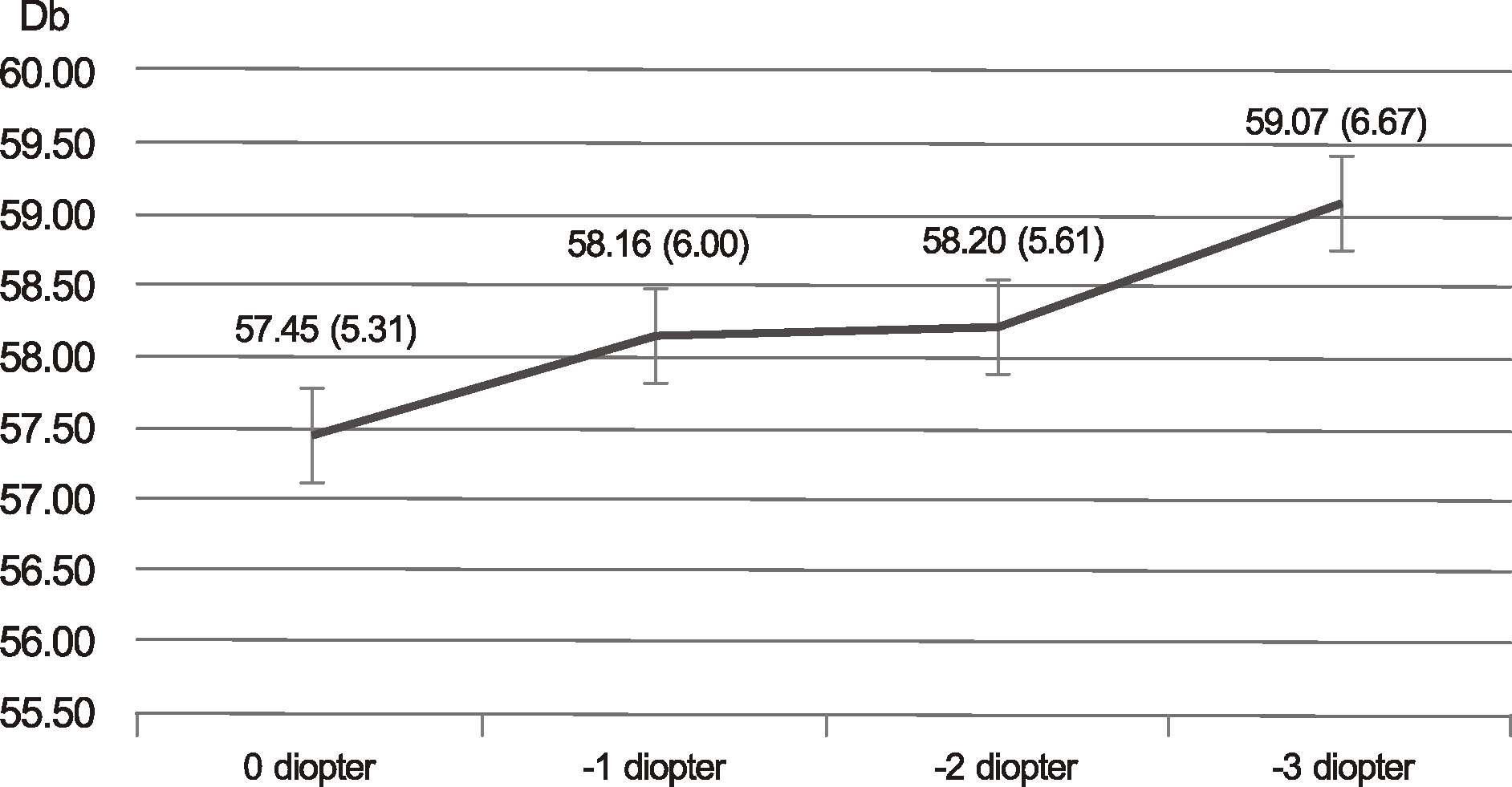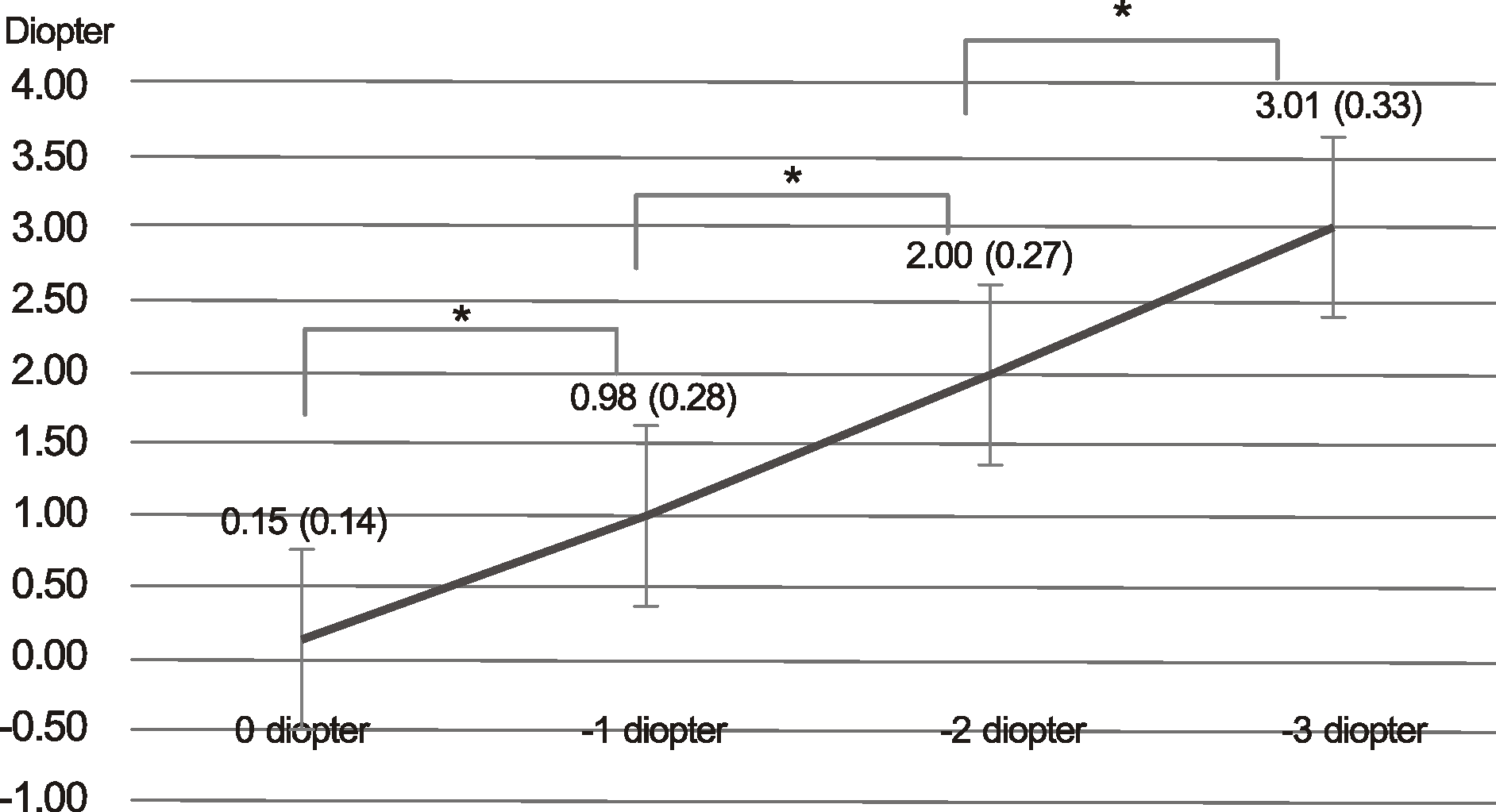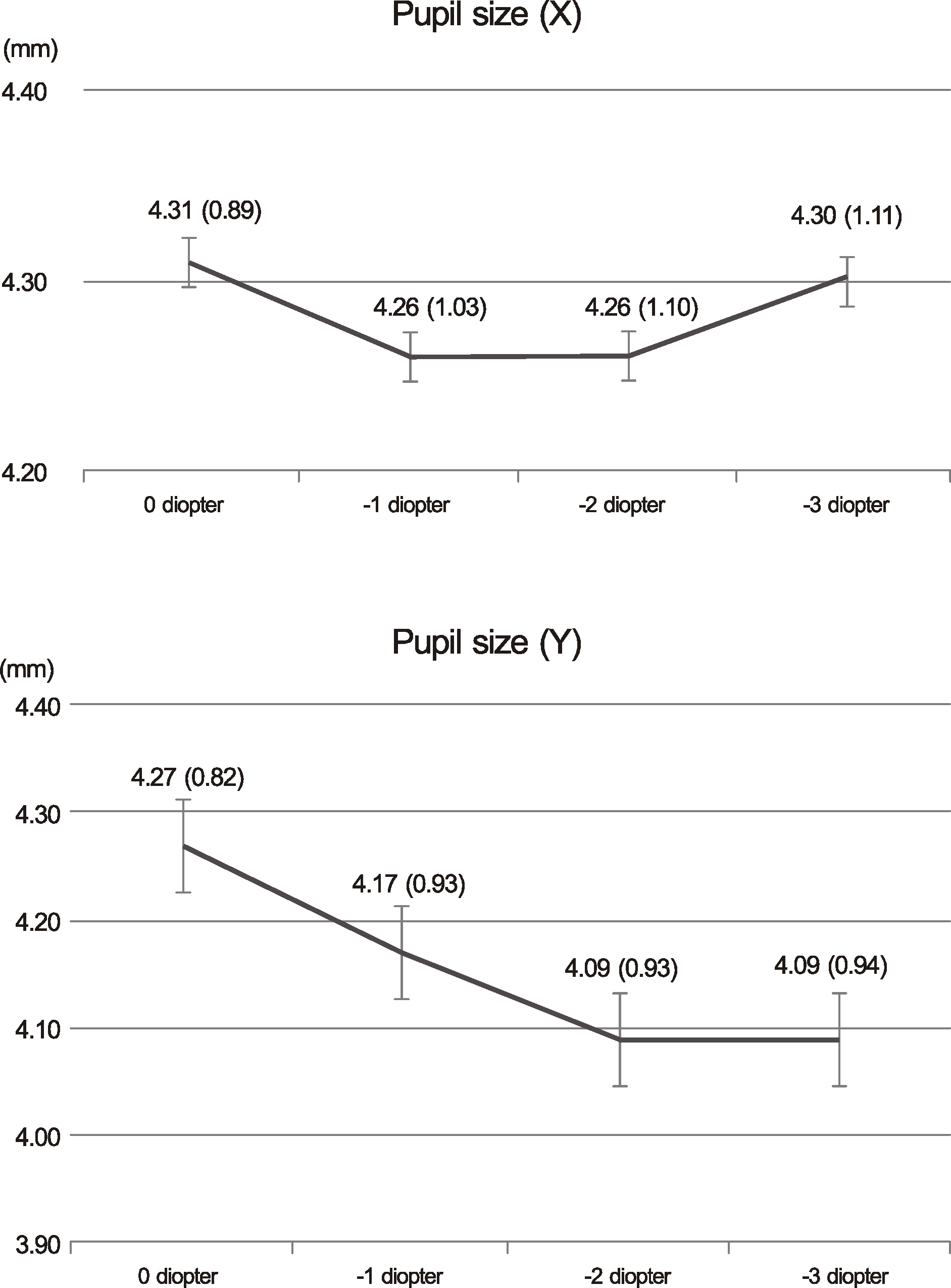Abstract
Purpose
To determine the relationship between the high-frequency component of accommodative microfluctuation (HFC) and accommodative lag in presbyopic eyes and how they affect the subjective accommodation power with other ophthalmic factors, such as pupil diameter and corneal multifocality.
Methods
Forty subjects (80 eyes) were included in this study, and the non-corrected distance and near visual acuity was measured and then converted to log MAR vision. The addition power for 33 cm near visual work was also measured and the accommodative power was measured by the push-up method. The HFC, accommodative lag and pupil size according to accommodative stimuli (−1.0 to −3.0 D) was measured by Speedy-i Autorefractor (Right Mfg Co., Tokyo). The corneal multifocality and corneal astigmatism was measured by corneal topography (TMS-4; Tomey, Erlangen, Germany).
Results
The mean age was 60.0 ± 4.66 years (51-68) and there were 23 male and 17 female subjects (1.35:1). The HFC and pupil size showed no significant change according to accommodation demand, however, the accommodative lag showed a statistically significant increase (p < 0.001 by one-way ANOVA). Accommodative lag (-2.0 D) showed a statistically significant negative correlation with the subjective accommodative power, and the pupil size (0 D) showed a positive correlation with the subjective accommodative power.
Conclusions
In presbyopia patients, the objective accommodative lag and initial pupil size showed a statistically significant relationship with subjective accommodative power. On the other hand, HFC, pupil size and corneal multifocality, alone may not be indicators to predict accommodative power, but these are important components to explain the dynamic aspect of accommodation.
References
1. von Helmholtz H. Uber dir akkommodation des auges. Archiv Ophthalmol. 1855; 1:1–89.
2. Fukuyama M, Oshika T, Amano S, Yoshitomi F. Relationship between apparent accomodation and corneal multifocality in pseudophakic eyes. Ophthalmology. 1999; 106:1178–81.
3. Kamiya K, Kawamorita T, Uozato H, et al. Effect of astigmatism on apparent accommodation in pseudophakic eyes. Optom Vis Sci. 2012; 89:148–54.

4. Nishi T, Nawa Y, Ueda T, et al. Effect of total higher-order aberrations on accommodation in pseudophakic eyes. J Cataract Refract Surg. 2006; 32:1643–9.

5. Leonard Levin, Siv Nilsson, James Ver Hoeve, et al. Accommodation. Adrian Glasser, editor. Adler's Physiology of the EYE. 11th ed.Elsevier Saunders;2011. chap. 3.
6. CAMPBELL FW, ROBSON JG, WESTHEIMER G. Fluctuations of accommodation under steady viewing conditions. J Physiol. 1959; 145:579–94.

7. Gray LS, Winn B, Gilmartin B. Accommodative microfluctuations and pupil diameter. Vision Res. 1993; 33:2083–90.

8. Morgan MW. Accommodation and its relationship to convergence. Am J Optom Arch Am Acad Optom. 1944; 21:183–95.

9. Nakatsuka C, Hasebe S, Nonaka F, Ohtsuki H. Accommodative lag under habitual seeing conditions: comparison between adult myopes and emmetropes. Jpn J Ophthalmol. 2003; 47:291–8.

10. Koretz JF, Kaufman PL, Neider MW, Goeckner PA. Accommodation and presbyopia in the human eye–aging of the anterior segment. Vision Res. 1989; 29:1685–92.

11. Ostrin LA, Glasser A. Accommodation measurements in a pre-presbyopic and presbyopic population. J Cataract Refract Surg. 2004; 30:1435–44.

13. Collins M, Davis B, Wood J. Microfluctuations of steady-state accommodation and the cardiopulmonary system. Vision Res. 1995; 35:2491–502.

14. Gray LS, Winn B, Gilmartin B. Effect of target luminance on microfluctuations of accommodation. Ophthalmic Physiol Opt. 1993; 13:258–65.

15. Toshida K, Okuyama F, Tokoro T. Influences of the accommodative stimulus and aging on the accommodative microfluctuations. Optom Vis Sci. 1998; 75:221–6.

16. Winn B, Pugh JR, Gilmartin B, Owens H. The frequency characteristics of accommodative microfluctuations for central and peripheral zones of the human crystalline lens. Vision Res. 1990; 30:1093–9.

17. Schultz KE, Sinnott LT, Mutti DO, Bailey MD. Accommodative fluctuations, lens tension, and ciliary body thickness in children. Optom Vis Sci. 2009; 86:677–84.

18. van der Heijde GL, Beers AP, Dubbelman M. Microfluctuations of steady-state accommodation measured with ultrasonography. Ophthalmic Physiol Opt. 1996; 16:216–21.

19. Gwiazda J, Thorn F, Bauer J, Held R. Myopic children show insufficient accommodative response to blur. Invest Ophthalmol Vis Sci. 1993; 34:690–4.
20. Nakatsuka C, Hasebe S, Nonaka F, Ohtsuki H. Accommodative lag under habitual seeing conditions: comparison between myopic and emmetropic children. Jpn J Ophthalmol. 2005; 49:189–94.

Figure 1.
The high-frequency component (HFC) of microfluctuation according to accommodative demand. There was no significant change in HFC according to stimulus (p = 0.379 by one-way ANOVA). Db = decibel.

Figure 2.
The accommodative lag according to accommodative demand. There was a significant increase in accommodative lag according to stimulus (p < 0.001 by one-way ANOVA). ∗p < 0.001 by Scheffe & Bonferroni analysis.

Figure 3.
The pupil size according to accommodative demand. There was no significant change in pupil size according to stimulus, but the vertical axis showed more continuous constriction rather than horizontal as a result of near complex.

Table 1.
Baseline characteristics of eyes (n = 80)
| mean ± SD | Range | |
|---|---|---|
| Age (years) | 60.0 ± 4.67 | 51-68 |
| Sex (M:F) | 1.35:1 | |
| UCVA-far (log MAR) | 0.27 ± 0.36 | 0.00-2.00 |
| UCVA-near (log MAR) | 0.75 ± 0.35 | 0.00-1.60 |
| Sphere (diopter) | +0.67 ± 1.11 | −2.00∼+3.00 |
| Cylinder (diopter) | −0.67 ± 0.53 | −1.75∼0.00 |
| SE (diopter) | +0.32 ± 1.11 | −2.63∼+2.50 |
| Add power∗ (diopter) | +2.15 ± 0.04 | + 1.50∼+3.00 |
| Corneal multifocality (diopter) | 1.52 ± 0.11 | +0.23∼+3.23 |
| Corneal astigmatism (sim K) (diopter) | −0.76 ± 0.74 | −3.85-0.61 |
| Accommodative power by push-up method (diopter) | 4.50 ± 1.22 | 2.10-7.10 |
Table 2.
High-frequency component (HFC) of accommodation and accommodation lag according to accommodation stimuli
| Stimulus (diopter) | HFC (dB) | Accommodative lag (diopter) |
|---|---|---|
| -0.0 | 57.45 ± 5.31 | 0.15 ± 0.14 |
| -1.0 | 58.16 ± 6.00 | 0.98 ± 0.28 |
| -2.0 | 58.20 ± 5.61 | 2.00 ± 0.27 |
| -3.0 | 59.07 ± 6.67 | 3.01 ± 0.33 |
Table 3.
Pupil size according to accommodation stimuli
| Stimulus (diopter) | Horizontal size (X) (mm) | Vertical size (Y) (mm) |
|---|---|---|
| -0.0 | 4.31 ± 0.89 | 4.27 ± 0.82 |
| -1.0 | 4.26 ± 1.03 | 4.17 ± 0.93 |
| -2.0 | 4.26 ± 1.10 | 4.09 ± 0.93 |
| -3.0 | 4.30 ± 1.11 | 4.09 ± 0.94 |
Table 4.
Pearson correlation analysis for accommodative power and other independent variables
| Correlation coefficients | p-value∗(p < 0.05) | |
|---|---|---|
| Age (years) | 0.214 | 0.061 |
| Sphere | −0.207 | 0.066 |
| Cylinder | −0.032 | 0.776 |
| SE | −0.208 | 0.064 |
| -0.0 D HFC | −0.105 | 0.355 |
| -1.0 D HFC | 0.028 | 0.806 |
| -2.0 D HFC | −0.047 | 0.678 |
| -3.0 D HFC | −0.022 | 0.847 |
| -0.0 D accommodative lag | −0.134 | 0.238 |
| -1.0 D accommodative lag | 0.011 | 0.925 |
| -2.0 D accommodative lag | −0.406 | <0.001† |
| -3.0 D accommodative lag | 0.065 | 0.565 |
| UCVA (far) | 0.202 | 0.073 |
| UCVA (near) | −0.181 | 0.109 |
| 0 D pupil size x | 0.365 | 0.001† |
| 0 D pupil size y | 0.301 | 0.007† |
| -1.0 D pupil size x | 0.161 | 0.154 |
| -1.0 D pupil size y | 0.088 | 0.440 |
| -2.0 D pupil size x | 0.060 | 0.600 |
| -2.0 D pupil size y | −0.050 | 0.658 |
| -3.0 D pupil size x | 0.109 | 0.336 |
| -3.0 D pupil size y | 0.068 | 0.552 |
| Sim K | −0.206 | 0.100 |
| Corneal multifocality | −0.175 | 0.223 |




 PDF
PDF ePub
ePub Citation
Citation Print
Print


 XML Download
XML Download